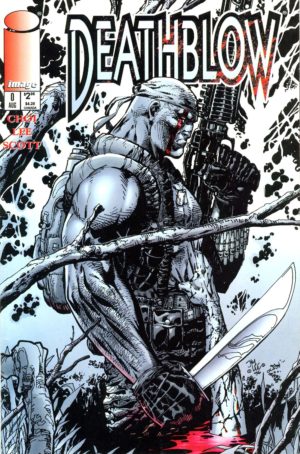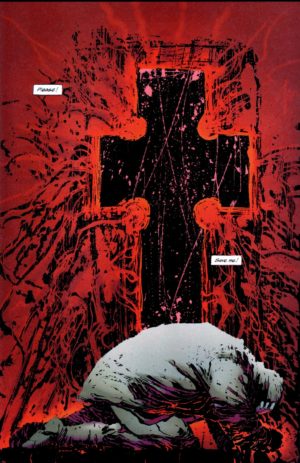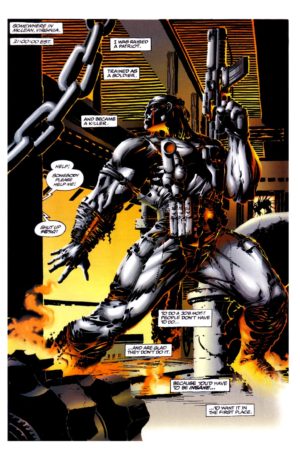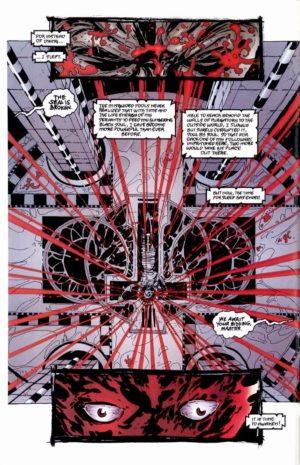[Patreon-Nov16-Post-Bug][/Patreon-Nov16-Post-Bug] Deathblow was the third book in Jim Lee’s trio of WildStorm launch titles, introducing his own analog to The Punisher – one of his famous runs as a penciller at Marvel in the late 80s.
Deathblow was the third book in Jim Lee’s trio of WildStorm launch titles, introducing his own analog to The Punisher – one of his famous runs as a penciller at Marvel in the late 80s.
(The character was first introduced in a brief tale in the anthology Darker Image, although that story doesn’t track directly to the beginning of the series and would be completed in a #0 issue.)
Deathblow would later coalesce into a remarkably gripping story, but at its introduction the book was a mere footnote to WildStorm’s pair of flagship teams. That’s due to a staggered publishing schedule and four short, disconnected issues that don’t feel like they had Lee and scripter Brandon Choi’s full focus.
That’s puzzling, as Deathblow begins with the most traditional opening arc of all three of the initial WildStorm titles. We get time to linger on our anti-hero and his relationships before being plunged into action. Why isn’t it satisfying?
At this early stage of their independence, Lee and Choi didn’t know how to deliver information while keeping a story in motion. As a result, the first three chapters of the story feel like prologue, while the brief action sequence and bizarre twist in the fourth hardly pays off all the set-up.
While the story was a muddle, Deathblow remains notable as a rare example of Jim Lee inking himself. The style is striking. It retains all of the dynamics of Lee’s typical work, but drapes them in shadows and negative space. It’s a much more dark, rough-hewn look than his typically sharp pencils. It almost suggests Frank Miller or Jae Lee’s inky style. Jim Lee also plays with silhouettes and reversing out foreground details in a single color from the backdrop.
The unusual style is emphasized by a desaturated color palette of grays and greens. Most characters are colored as pale white ghosts or sickly yellow specters. Any hints of red are reserved for the lines under Deathblow’s eyes, religious imagery, and bursts of occasional violence. It’s a bold, memorable choice, but the early days of digital color don’t do it full justice. The high contrast looks smudged where colors meet, and inexact gradients swallow up Lee’s penwork.
Tim Sale takes over finishes duty over Lee’s layouts in the third issue. Sale isn’t as detail-obsessed as Lee, and as he settles into his simpler style the art begins to gel more with the early digital colors. This would coalesce into a beautiful, minimalist look that would last through issue #12, though Lee would continue providing misleading hyper-detailed covers
There’s little to recommend this early run, which reads like the worst of everything Image was accused of in its early days. Even if the between-issue delays are invisible to us now, the stories are short, incoherent, and try to push as many “cool” and” x-treme!” buttons as they can in their brief page count.
Want the play-by-play? I’ll get into the nitty-gritty of Dark Image, Deathblow #1-4, and #0 below. Here’s the schedule for the rest of this month’s WildStorm re-read – tomorrow I tackle WildC.A.T.s Special #1 and WildC.A.T.s Trilogy #1-3.
Need the issues? Deathblow #1-4 (and on through #12) was collected in a 1999 TPB titled “Sinners and Saints.” DC issued a revised, expanded, and re-ordered HC and TPB of #0-12 that are still readily available. For single issues try eBay (Darker Image & #0-4) or Amazon (Darker Image, #0, 1, 2, 3, 4)
![]()
Deathblow was introduced in a featured story in Darker Image #1, which also introduced The Maxx! That story was later expanded in Deathblow #0. Since we didn’t have all of the information from #0 when we started reading #1 back in 1993, my preferred reading order is Darker Image #1 (which #o up to the 9th page, with the “Super Powered Being” footnote), #1-4, and then #0.
 In the Darker Image #1 story, we find Deathblow deep in-country, floating up a humid river in a boat before executing his informant smuggler. That’s all we get of Deathblow. So much for introducing the character!
In the Darker Image #1 story, we find Deathblow deep in-country, floating up a humid river in a boat before executing his informant smuggler. That’s all we get of Deathblow. So much for introducing the character!
Instead, this preview is notable for featuring Director Lynch, who appeared briefly in the context of I.O. in WildC.A.T.s #2. In a single page, Lynch delivers a lot of dialog that makes #1-4 resonate more strongly – that Deathblow is a former Navy Seal who is AWOL after a messy situation in Costa Mesa where his partner was captured, and later tortured. And, that he was dying. He also dispenses a former teammate of Deathblow’s to track and kill him in Costa Mesa before he can dispose of a dictator that the US isn’t ready to see eliminated.
There’s little story to be found here, and what there is reads badly. Brandon Choi’s dialog is uncharacteristically choppy – in #0 he says it’s “too humid to sweat” on one page and then writes about dripping sweat on the next. However, it introduces the self-inking Lee and the desaturated color scheme that would come to define Deathblow. It feels like a flipped palette where all the greens ought to be reds. The sickly, unsettling color scheme gives the eery feeling that we’re inhabiting a ghostly world that exists as a flipside to our own.
Deathblow #1 finds Deathblow back in Washington D.C. much later, though it’s initially unclear if this is before or after the events of Darker Image. He is praying in a church, asking forgiveness for his many acts of violence and terror. Is he entirely in control of his actions when he turns from hired merc to frenzied killer, or does he disappear into his darkness each time? Is it that same darkness that prevents him from killing himself?
Deathblow flees the church and returns to his truck, but not before stepping upon a tabloid which ominously claims, “Miracle Boy in Philadelphia! Brings dead friend back to life!”
 We start in the thick of action in Deathblow #2, which it turns out to be Deathblow handily dispatching a training program with a series of split-second head-shots. His operator Travis spectates, dryly egging him on before mentioning the church where Deathblow lingered in the prior issue and the brain cancer that’s slowly killing him. An off-hand mention of “taking those boys down in Costa Mesa” seems to indicate this occurs after the #0 story, and that the AWOL Deathblow is now begrudgingly back in the fold.
We start in the thick of action in Deathblow #2, which it turns out to be Deathblow handily dispatching a training program with a series of split-second head-shots. His operator Travis spectates, dryly egging him on before mentioning the church where Deathblow lingered in the prior issue and the brain cancer that’s slowly killing him. An off-hand mention of “taking those boys down in Costa Mesa” seems to indicate this occurs after the #0 story, and that the AWOL Deathblow is now begrudgingly back in the fold.
His mission (from the omnipresent Lynch, an untrustworthy actor seemingly embedded in both the US government and International Operations) is to take out an Iraqi Intelligence Center, echoing the ties to current real-world events in Stormwatch. If Image was going for a ripped-from-the-headlines feel to these early books, it definitely resonates even over 25 years later.
Deathblow #3 opens with a hairpin turn that redefines the series and our view of Deathblow. We see a group of Iraqi Republican Guard soldiers digging away through rock and sand in the desert near the Syrian border. They uncover an ancient sigil – a cross with an inset of a sword crossed with a pair of daggers. Suddenly, their colonel murders them, “because the Black Angel told me” to “break the seal on the gates of Purgatory.”
That earns a creepy “yyyeeessss” in response tucked into the bottom corner of the page, and results in a page right out of a 50s EC horror book as the dripping blood of the slaughtered cascades down onto an emaciated corpse.
Even more shocking, Deathblow – on a plane heading to Baghdad – seems to feel this awakening immediately and viscerally. He nearly leaps from the plane in horror and desperation.
The first issue was laden with religious imagery that suggested a story grounded in faith, but it did not prepare us for the Punisher-like Deathblow to be suddenly thrown into the midst of a supernatural conspiracy. In fact, this is the first hint of non-science-fiction fantastical elements of the WildStorm world (although they had been well-established in the wider realm of Image largely thanks to Spawn).
 Despite his intense horror at what might be unleashed, Deathblow agrees to continue his mission.
Despite his intense horror at what might be unleashed, Deathblow agrees to continue his mission.
Deathblow #4 finally puts us in the center of a conflict, although after all the buildup of how deadly Deathblow can be his quickly dispatching our Saddam Hussein stand-in “Kussein” is anti-climactic (although he’s apparently a body-double for the real dictator). Deathblow’s team is unexpectedly decimated by a warrior priest, who had just arrived to warn Kussein about the site in the desert from #3, but he is also quickly dispatched by Deathblow (who reacts to killing a priest with requisite horror).
With their military target dispatched, Deathblow and the remaining mercs exfiltrate. In their wake, a group of lich-like creatures rise to prowl the desert – and their leader seems to have a vendetta for Deathblow.
Yep – that doesn’t make a lick of sense … at least, until you read the completed introductory story in Deathblow #0, which is worlds more coherent than this lumpy first arc while hitting many of the same story beats.
We pick up Deathblow after the Lynch scene. He’s is in a race against the team sent to pursue him, trying to beat them to the compound of the Costa Mesa dictator who tortured his friend. The pursuit team is whittled down by both enemy forces and Deathblow himself until we’re down to just their leader and Deathblow in a confrontation with the dictator, who has made a literal deal with the devil and transforms into a massive beast intent on killing them both.
(The implication is not lost on me – that the dictator has long been aligned with evil forces and that they may have been involved with Deathblow’s previous time in-country and subsequent escape.)
They dispatch the hellish monster, but when the young recruit refuses to let Deathblow walk away from the bloody scene he becomes yet another casualty.
This story should have been the opening arc of the series rather than bonus content tucked away in a non-sequential issue. It offers more action, more of the dissonance between Deathblow’s rogue actions and his service, more of Lynch’s duplicity, and a solid grounding for the supernatural elements of the series. The first arc would have made worlds more sense as a follow-up, as Deathblow murdering the team sent in his pursuit leads naturally to (and completely recontextualizes) the church scene in the first issue.